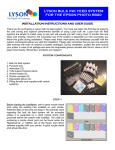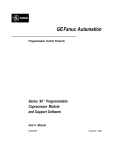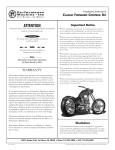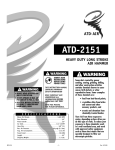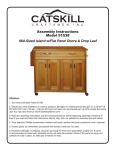Download The Unofficial Fox TALAS I Service Guide
Transcript
The Unofficial 32mm TALAS I (first generation) Service Guide Revision Number Revision Date Summary of Changes 1.0 2013-03-26 Initial transcription from FOX service slideshow 1.1 2013-04-16 Added notes to steps 18, 46, and 99. about.me/marpilli Page 1 of 28 The photos and text in this document were obtained from the Fox TALAS I (first generation) service slideshow: http://service.foxracingshox.com/consumers/Content/Service/Service_Videos/TALAS_SERVICE/ talas_service_video-WTEXT.html about.me/marpilli Page 2 of 28 1 Place the fork in a work stand. You’ll be turning the fork upside down so use one that allows for multiple orientations while holding the fork steady. 2 Remove the rebound knob using a 2mm hex key. If necessary, use a pair of pliers to hold the rebound knob securely as you turn the 2mm screw. Be sure to place tape on the pliers’ tips to protect the rebound knob from scratches. 3 After removing the screw, simply lift the rebound knob. Notice the orientation of the knob relative to the top of the shaft. The bottom of the rebound knob is keyed to the top of the shaft it attaches to. 4 RL/RLC ONLY: Using a 1.5mm hex key, unscrew the three lockout lever set screws. Do not completely remove the set screws. They also pull double duty holding in the balls that attach the lockout lever to the low speed compression bezel. about.me/marpilli Page 3 of 28 5 RL/RLC ONLY: After the set screws are loosened up, you will able to easily lift the lockout lever. Turn the lever upside down and notice the three balls. 6 RLC ONLY: After removing the lockout lever, you will see the low speed compression bezel. Nothing is holding it down now except gravity. Simply lift it up to remove it. 7 RLC ONLY: After removing the low speed compression bezel, take notice of another ball. Underneath this ball is a spring which keeps this ball loaded. It also provides the low speed compression bezel its tactile feedback when turning. 8 Using a dental pick or small screwdriver, carefully remove the ball and spring. Put them aside being careful not to loose them. about.me/marpilli Page 4 of 28 9 Remove the TALAS air cap from the top of the left fork leg. It can be a little tricky to grab properly. But, you can do it. 10 Now you can see the Schrader valve and locknut. We’ll be taking off the locknut next. 11 Using a 7/16” socket wrench, remove the locknut. 12 Nothing to know here except that that’s one wonderful looking locknut. Put it aside and be careful not to loose it. about.me/marpilli Page 5 of 28 13 After removing the locknut, the TALAS travel adjust knob comes of rather easily. Now is a good time to start cleaning parts as you take them off before sitting them aside. 14 After removing the TALAS travel adjust knob, you’ll see a lot of screws underneath it. The red one is the one we’re concerned with. That’s the TALAS IFP fill-up screw and within it lays the heart of the TALAS system. 15 Before we get to the screw, let’s take out another ball and spring set. Use a dental pick or small flat blade screwdriver to remove the ball and spring. Then set them aside. 16 Using a small flat blade screwdriver, unscrew the red IFP port screw. about.me/marpilli Page 6 of 28 17 Pull out the red IFP port screw and put it aside. 18 Screw the TALAS IFP tool into the IFP chamber port. NOTE: If you need to build your own TALAS IFP tool, please visit http://about.me/marpilli for a link to instructions. 19 At this point, you may want to use a rag to cover the IFP tool as you screw it in the IFP chamber. This will prevent any float fluid from squirting you in the face (or, worse, your eyes). 20 Depress the Schrader valve on the TALAS IFP tool. Again, use care when doing this so as not to get any float fluid squirted in your face or eyes. about.me/marpilli Page 7 of 28 21 Blue float fluid may (and probably will) seep out of the Schrader valve. This is normal. 22 After releasing the float fluid from the IFP chamber, go ahead and release the air from the TALAS main air chamber. 23 Go back to the Schrader valve on the IFP tool and release more air. 24 After both chambers are thoroughly deflated, you can now remove the TALAS IFP tool from the IFP chamber port. about.me/marpilli Page 8 of 28 25 Using a 26mm socket wrench, unscrew the TALAS side top cap. Do not fully unscrew the top cap. Unscrew it enough until you can just see the o-ring (as seen in the next photo). 26 Do not completely remove the TALAS side top cap since we will be turning the fork upside down. This will prevent any green float fluid from dripping from the top of the fork when removing the base nuts. 27 Using a 2mm hex key, unscrew the set screw on the blow-off threshold knob on the bottom of the right fork leg just enough so that you are able to remove the threshold knob. 28 When lifting the threshold knob, notice how the set screw and the indentation on the bottom of the adjuster shaft line up. This is necessary to note when putting the knob back on. about.me/marpilli Page 9 of 28 29 Using a 10mm socket wrench, remove the base stud nut from the bottom of the right fork leg. 30 Remove the plastic crush washer. You may need to use a dental pick if it proves difficult to remove. If you cannot see the crush washer, check the bottom of the base stud nut you just removed (it could be stuck in there). 31 Using a 10mm socket wrench, remove the base stud nut from the bottom of the left fork leg. 32 Notice that the bottom of the TALAS shaft is slightly different than the bottom of the damper side shaft assembly. The TALAS side uses an aluminum washer. Take notice so that the proper washer is placed on the correct side when reassembling. about.me/marpilli Page 10 of 28 33 Remove the aluminum washer from the bottom of the TALAS shaft. 34 Place the base stud nut back onto the base stud until it is flush with the end of the threshold adjuster rod. This is done to prevent damage to the adjuster rod. 35 Strike the base stud nut on both sides with a plastic faced hammer until the shafts are free. A good whack or two should suffice. 36 Place the fork over an oil pan as you will be draining fluid. about.me/marpilli Page 11 of 28 37 At this time you can go ahead and remove the crown steerer upper tube assembly from the lower legs. Be sure to do this over an oil pan as fluid will be draining through both sides. 38 Unthread the right top cap and remove the damper assembly from the right fork leg by pulling it straight up. 39 The damper cartridge still has some fluid in it. To release this fluid, use a 1.5mm hex key to push up on the check valve. Hold the shaft over an oil pan and let the remaining fluid to flow out. 40 While keeping the 1.5mm hex key pushed up against the check valve, grab the damper shaft with two hands (one on the cartridge body and the other on the top cap) and pump the shaft to squeeze out any remaining suspension fluid. about.me/marpilli Page 12 of 28 41 Unscrew the TALAS side top cap. 42 Remove the TALAS top cap from the lower leg by pulling the top cap straight up. 43 Pull the TALAS top cap up and out. Be prepared (with a rag) to clean up any float fluid that will leak out. 44 Clean the TALAS upper shaft with a lint free rag and set it aside until reassembly. about.me/marpilli Page 13 of 28 45 Remove the TALAS lower shaft by pushing up on the base nut. 46 Even with most of the lower shaft slid up in the upper tube; it may not come through the top very easily. Use a screwdriver to push up on the lower shaft. Be careful not to slip and scratch any of these parts. NOTE: Using a long socket extension is a better alternative than a screwdriver. 47 The TALAS lower shaft should now pop up through the top of the upper tube. And, you can pull it out the rest of the way. 48 Clean the TALAS lower shaft with a lint free rag. about.me/marpilli Page 14 of 28 49 Begin reassembly by pouring 3cc of float fluid into the left upper tube. Hold the fork at an angle so the fluid does not drip out of the bottom. 50 Insert the TALAS lower shaft into the upper tube. 51 Push the TALAS lower shaft until it protrudes from the bottom of the upper tube. Use a long plastic tool such as a 1/2 inch diameter piece PVC pipe to push the shaft all the way down. 52 Ensure that the lower shaft extends past the bottom of upper tube about the length of two fingers (give or take a finger). about.me/marpilli Page 15 of 28 53 Take a peek inside the left upper tube and notice the hole at the center. That’s where the end rod of the TALAS upper top cap assembly needs to go into. Pour 5cc (or one pillow-pack) of float fluid into the upper tube. 54 Insert the TALAS upper top cap assembly into the upper tube. Be sure to insert the end rod of the TALAS upper top cap assembly into the hole on top of the lower shaft assembly. 55 Pour 3cc of float fluid into the upper tube. 56 Push the TALAS upper top cap assembly all the way down. about.me/marpilli Page 16 of 28 57 Screw the top cap into the upper tube. 58 Torque the top cap to 165 inch pounds using a torque wrench. 59 Insert the TALAS IFP tool into the IFP chamber port. 60 Pressurize the IFP chamber to 150psi using a FOX high pressure pump. about.me/marpilli Page 17 of 28 61 Screw the red IFP port screw back into the IFP chamber port. 62 Screw the IFP port screw until it is snug. Do not over tighten. 63 Place the spring back into the detent. 64 Place the ball on top of the spring. about.me/marpilli Page 18 of 28 65 Use a dental pick to push the ball firmly into the detent. 66 Grease the bottom of the TALAS knob. 67 Engage the feature on the other side of the TALAS knob with the hex feature on the bottom of the Schrader valve housing. 68 Thread the air tank valve nut onto the Schrader valve. about.me/marpilli Page 19 of 28 69 Using a 7/16” socket, torque the air tank valve nut to 45 inch pounds using a torque wrench. 70 Using the FOX high pressure pump, inflate the main air chamber to 75psi (which is the factory setting). 71 Place the air cap back on to the Schrader valve. 72 Tighten the air cap by hand. about.me/marpilli Page 20 of 28 73 At this point you may want to replace the seals and foam rings on the lower legs. If so, you can use an open end wrench to pry the seals out from the lower leg. If they aren’t being replace, then clean them with a solvent and lint free rag. 74 Using this method of removing the seals and foam rings assumes you are going to replace those items. They are rendered useless after removing them using this method. 75 Pull out the foam rings. 76 To reinstall new seals, slide them on to the upper tubes. about.me/marpilli Page 21 of 28 77 Lubricate the foam rings with suspension fluid before placing them onto the upper tubes. 78 Slide the upper tubes into the lower legs ensuring that the forward crown offset is towards the fork brace. The shaft ends do not need to protrude from the bottom of the lower legs since you still need to fill the lower legs with fluid. 79 Once you have slid the upper tubes into the lower legs, use a blunt object (such as the flat end of an 8mm hex key wrench) to push the seals down into the lower legs. Press down equally on multiple sides of the seals to properly and evenly seat them. 80 Turn the fork upside down and pour 10cc of FOX suspension fluid into the bottom of the TALAS side of the fork. about.me/marpilli Page 22 of 28 81 After putting in the suspension fluid, you can now push down on the lower legs until the base studs poke through the bottom of the lower legs. You may need to guide the base studs through the hole using a screwdriver to center the shaft. 82 Place an aluminum crush washer on the TALAS side stud and screw the base stud nut onto the shaft. 83 Torque the base stud nut to 50 inch pounds using a torque wrench. 84 Insert the damper assembly into the right side upper tube until the base stud protrudes through the bottom of the lower leg. Throw the top cap into the upper tube a couple of turns to hold it in place. about.me/marpilli Page 23 of 28 85 Make sure that the base stud protrudes from the bottom of the lower leg. You may need to use a screwdriver or dental pick to help guide the base stud through the hole in the lower leg as you push the base stud up. 86 Place a new crush washer on the damper shaft base stud. Make sure you are placing the black plastic washer on this side. The aluminum washer is used on the TALAS side. 87 Ensure that the crush washer is firmly seated against the bottom of the lower leg. 88 Thread the base stud nut onto the damper shaft. about.me/marpilli Page 24 of 28 89 Torque the base stud nut to 50 inch pounds using a torque wrench. 90 Before placing the blow off threshold knob back onto the shaft end, line up the set screw on the knob with the divot on the shaft. 91 Using a 2mm hex key, tighten the set screw so that it engages with the divot on the shaft. 92 Pour 160cc of suspension fluid in the damper side top cap. Screw the top cap on by hand. about.me/marpilli Page 25 of 28 93 Torque the top cap to 165 inch pounds using a torque wrench. 94 Place the spring in the detent of the damper side top cap. 95 Place the ball on top of the spring. Make sure the ball is properly engaged by pushing on it with a dental pick. 96 RLC Only: Grease the low speed compression bezel. about.me/marpilli Page 26 of 28 97 RLC Only: Place the low speed compression bezel in the top cap by aligning any one of the divots on the bottom of the bezel with the ball and spring assembly in the top cap. 98 RLC/RL Only: To orient the lockout lever, place the lockout lever on the octagonal slats of the lock out shaft assembly. Turn the lever as far clockwise as it will go. Remove the lockout lever and repeat until the shaft no longer turns clockwise. 99 RLC/RL Only: Finish orienting the lockout lever by removing it and placing it back on so that the lever is at approximately the 12’oclock position. This is the unlocked position. NOTE: You should actually place the lever back on so that it is at approximately the 6’oclock position. This is the locked position. 100 RLC/RL Only: Use a 1.5mm hex hey and lightly tighten the three set screws. Now loosen the set screws back only 1/2 turn. Test the action of the lock out lever by making sure it locks out at approximately the 6’oclock position. about.me/marpilli Page 27 of 28 101 Place the red rebound knob on the end of the rebound adjuster rod assembly. Note the oval shape on the rebound knob and the top of the rebound adjuster rod. 102 Tighten the set screw on the rebound knob. Do not over tighten. 103 Cycle the fork a few times to pump suspension and float fluid throughout the fork. Refer to the FOX forks service manual for detailed service instructions on the internal assemblies. about.me/marpilli Page 28 of 28




























